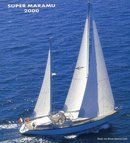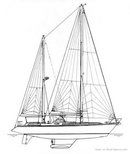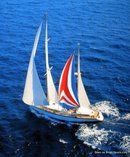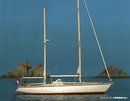Super Maramu 2000
Sailboat specifications
The Super Maramu 2000 is a 52’6” (16m) cruising sailboat designed by Henri Amel (France) and Jacques Carteau (France). She was built between 2000 and 2007 by Amel (France) with 247 hulls completed.
Super Maramu 2000's main features
- Model
- Super Maramu 2000
- Hull type
- Monohull
- Category
- Offshore cruising sailboat
- Sailboat builder
- Sailboat designer
- Country
- France
- Construction
- Hull and deck: GRP (glass reinforced polyester)
- Number of hulls built
- 247
- First built hull
- 2000
- Last built hull
- 2007
- Appendages
- Keel : L-shaped keel (with bulb)
- Helm
- Single helm wheel
- Rudder
- Single rudder on skeg
- Unsinkable
- No
- Trailerable
- No
- EC design categoryiThe CE design category indicates the ability to cope with certain weather conditions (the sailboat is designed for these conditions)
A: Wind < force 9, Waves < 10m
B: Wind < force 8, Waves < 8m
C: Wind < force 6, Waves < 4m
D: Wind < force 4, Waves < 0,5m - A
- Standard public price ex. VAT (indicative only)
- N/A €
Super Maramu 2000's main dimensions
- Hull length
- 52’ 6”16 m
- Waterline length
- 41’ 4”12.6 m
- Beam (width)
- 15’ 1”4.6 m
- Draft
- 6’ 8”2.05 m
- Mast height from DWL
- 65’ 8”20.02 m
- Light displacement (MLC)
- 35274 lb16000 kg
- Ballast weight
- 12125 lb5500 kg
- Ballast type
- Lead
Super Maramu 2000's rig and sails
- Upwind sail area
- 1281 ft²119 m²
- Downwind sail area
- 1528 ft²142 m²
- Mainsail area
- 377 ft²35 m²
- Mizzen sail area
- 205 ft²19 m²
- Mizzen staysail area
- 215 ft²20 m²
- Genoa area
- 700 ft²65 m²
- Jib area
- 215 ft²20 m²
- Symmetric spinnaker area
- 732 ft²68 m²
- Rigging type
- Ketch Marconi (in-mast furling mainsail) masthead
- Mast configuration
- Deck stepped mast
- Rotating spars
- No
- Number of levels of spreaders
- 2
- Spreaders angle
- 0 °
- Spars construction
- Aluminum spars
- Standing rigging
- 1x19 strand wire discontinuous
Super Maramu 2000's performances
- Upwind sail area to displacementiThe ratio sail area to displacement is obtained by dividing the sail area by the boat's displaced volume to the power two-thirds.
The ratio sail area to displacement can be used to compare the relative sail plan of different sailboats no matter what their size.
Upwind: under 18 the ratio indicates a cruise oriented sailboat with limited performances especially in light wind, while over 25 it indicates a fast sailboat. - 202 ft²/T18.74 m²/T
- Downwind sail area to displacementiThe ratio sail area to displacement is obtained by dividing the sail area by the boat's displaced volume to the power two-thirds.
The ratio sail area to displacement can be used to compare the relative sail plan of different sailboats no matter what their size. - 207 ft²/T19.21 m²/T
- Displacement-length ratio (DLR)iThe Displacement Length Ratio (DLR) is a figure that points out the boat's weight compared to its waterline length. The DLR is obtained by dividing the boat's displacement in tons by the cube of one one-hundredth of the waterline length (in feet).
The DLR can be used to compare the relative mass of different sailboats no matter what their length:
a DLR less than 180 is indicative of a really light sailboat (race boat made for planning), while a DLR greater than 300 is indicative of a heavy cruising sailboat. - 226
- Ballast ratioiThe Ballast ratio is an indicator of stability; it is obtained by dividing the boat's displacement by the mass of the ballast. Since the stability depends also of the hull shapes and the position of the center of gravity, only the boats with similar ballast arrangements and hull shapes should be compared.
The higher the ballast ratio is, the greater is the stability. - 34 %
- Critical hull speediAs a ship moves in the water, it creates standing waves that oppose its movement. This effect increases dramatically the resistance when the boat reaches a speed-length ratio (speed-length ratio is the ratio between the speed in knots and the square root of the waterline length in feet) of about 1.2 (corresponding to a Froude Number of 0.35) . This very sharp rise in resistance, between speed-length ratio of 1.2 to 1.5, is insurmountable for heavy sailboats and so becomes an apparent barrier. This leads to the concept of "hull speed".
The hull speed is obtained by multiplying the square root of the waterline length (in feet) by 1.34. - 8.62 knots
Super Maramu 2000's auxiliary engine
- Engine(s)
- 1 inboard engine
- Engine(s) power
- 100 HP
- Fuel type
- Diesel
- Fuel tank capacity
- 158.5 gal600 liters
Super Maramu 2000's accommodations and layout
- Cockpit
- Center cockpit
- Cabin(s)
- 2
- Berth(s) (min./max.)
- 6 / 8
- Head(s)
- 2
- Freshwater tank capacity
- 264.2 gal1000 liters
- Maximum headroom
- 6’ 7”2 m
Similar sailboats that may interest you:
Sailboats
First built hull
Hull length
1978
45’ 4”13.8 m
2004
49’ 2”14.99 m
2014
49’ 2”14.99 m
1988
52’ 6”16 m
2005
53’ 10”16.4 m
2012
54’ 8”16.68 m
2012
54’ 11”16.72 m
2010
63’ 1”19.22 m
1995
48’ 6”14.78 m
2013
52’ 11”16.12 m
2013
52’ 11”16.12 m
2017
50’ 11”15.51 m
2018
48’14.63 m
1992
48’ 10”14.88 m
2019
53’ 6”16.3 m








